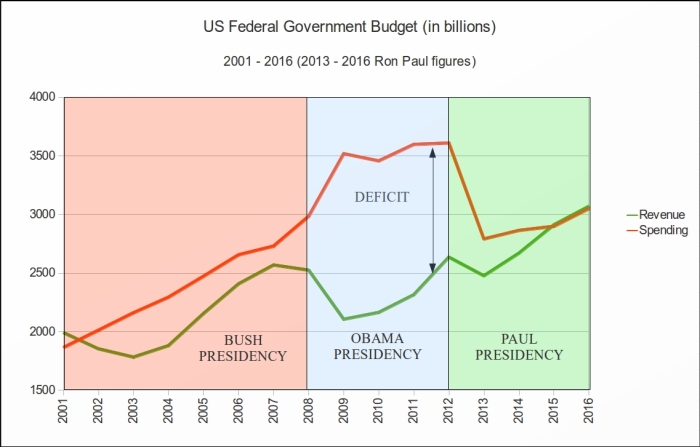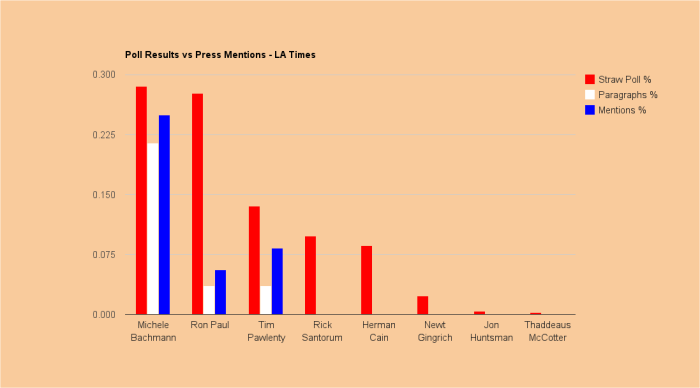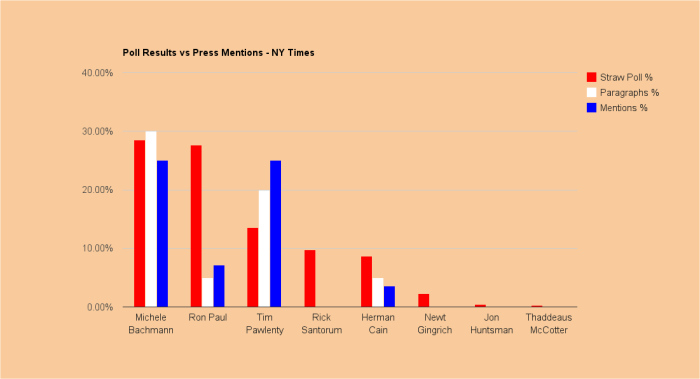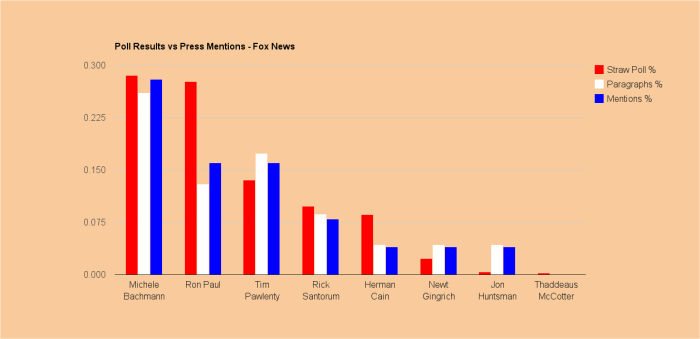Posts Tagged ‘presidential nominee’
Ron Paul Releases “Plan to Restore America”; Promises Balanced Budget in Third Year of Presidency
 Dr. Ron Paul, one of the Republican Presidential nominee hopefuls, and currently averaging third place in recent polls (trailing Herman Cain and Mitt Romney), has released his economic plan, the “Plan to Restore America“.
Dr. Ron Paul, one of the Republican Presidential nominee hopefuls, and currently averaging third place in recent polls (trailing Herman Cain and Mitt Romney), has released his economic plan, the “Plan to Restore America“.
The plan outlines significant changes to the United States federal government, and promises a balanced budget by Mr Paul’s third year in office, primarily by way of the elimination of the Department of Energy, the Department of Commerce, the Department of the Interior, the Department of Education and the Department of Housing and Urban Development, as well as significant cuts to the Department of Defense and Medicaid. No additional tax sources are proposed.
What is, perhaps, most striking about Ron Paul’s plan isn’t the reduced role of the federal government, but rather the significant reductions in spending required to balance the budget. The US federal government’s deficit, which President George W. Bush gave birth to, and which President Obama nurtured into an accelerated adulthood, is truly astonishing, in both its size and the rapidity with which it grew during the Obama administration.
Here’s a look US federal revenues and expenditures over the past two administrations, as well as the impact of Dr. Paul’s plan:

In the absence of significant budgetary changes, the United States federal government is on a dire path indeed: over 40% of all federal government spending is done with borrowed money; over one in seven US workers works for government of one level or another (by comparison, in bankrupt Greece, that ratio is one in five), which is more than the number of people working in manufacturing and construction combined; at the time Social Security was founded, there were thirty workers paying for each one retiree, while today that ratio is three to one (and nearing two to one); medical costs continue to rise more quickly than inflation (this is significant, because close to 70% of all medical spending in the US is by government).
Ron Paul’s plan begins to make some of those difficult choices which are increasingly becoming unavoidable, and further has one big advantage over most other plans presented by the GOP Presidential hopefuls: an even-handed approach which doesn’t single out special interests or seek to carve out exceptions for favored groups (by contrast, the floundering Rick Santorum started his attack on Herman Cain’s “9-9-9” tax plan at the GOP debate in Las Vegas Tuesday by suggesting that the federal government is obligated to subsidize certain groups of people in order to produce children – one of his pet causes which he feels the government should change the rules for. Most of the candidate (with the notable exception of Herman Cain) favor continuing the type of patchwork the current 72,000 page tax code employs: an extraordinary number of special exceptions for certain favored groups).
It will be interesting to see how the media reacts to Mr Paul’s proposal, which makes choices which return government spending to a level supported by government revenues, without increasing the source or scope of those revenues.
Media’s Coverage of Ron Paul Takes Another Strange Turn: NY Times’ Strange RSS Feed…
Representative Ron Paul, one of the Republican Presidential nominee hopefuls, continues to receive strange treatment by the media. Despite polling results consistently in the top three or four candidates, and often polling ahead of President Obama in hypothetical match ups with the President, Dr Paul is often but a footnote, at best, in mainstream media coverage of the nomination race, and more commonly simply not mentioned. We examined this in some detail in our article “Is Ron Paul Getting a Fair Shake in the Media? Watching the Watchers“, following Ron Paul’s narrow loss to Michele Backmann in the Iowa straw poll. Today, the New York Times got into the act, in a particularly odd way: the paper’s RSS feed pushed out a story with the title, “Romney, Perry and Cain Open Wide Financial Lead Over Field”.
The problem? The article’s title indicates a story about the recently released campaign fundraising figures for the past quarter, and states Herman Cain, along with Mitt Romney and Rick Perry, are far ahead of the other candidates. Except the title is flat out wrong: Mitt Romney and Rick Perry certainly raised considerable sums in the most recent quarter: $14 million and $17 million respectively. Herman Cain, however, raised just $2.8 million, $675,000 of which he personally loaned his campaign, meaning he actually raised $2.125 million. Ron Paul, on the other hand, raised four times more in campaign contributions: $8.2 million, and finished in third place among GOP Presidential hopefuls. In fact, Michele Backmann also raised more than Cain: her total for the reporting period was $3.9 million, or double Cain’s and half Paul’s. A factually correct title would read, “Romney, Perry and Paul Open Wide Financial Lead Over Field”.
What’s even stranger is that the linked article (the title of which is actually “Romney Beating Obama in a Fight for Wall St. Cash”) is not even really about what the RSS title and original headline purport it to be about: instead, the article is about the shift in donations by Wall Street firms, from previously strongly supporting Obama (who dominated by a country mile campaign contributions from these firms in 2008) to now supporting Romney, and makes no mention of Ron Paul at all, except for one sentence in the fourth final paragraph. The article spends 19 paragraphs discussing Wall Street political contributions before closing with nine paragraphs reporting the campaign contributions for the latest quarter (Herman Cain gets half a sentence).
Here are some interesting screen shots, starting with the RSS feed’s title:

And here’s the URL for the article, as seen in a browser address bar:
Here’s the actual article. Note the different title, versus the RSS feed’s title, as well as the title contained in the address bar:

Of course, the false title was picked up by innumerable other publications, blogs and web sites:

It seems the anti-Paul media bias has gone from largely ignoring Mr Paul to flat out mis-stating facts. Very strange indeed.
Perry vs Romney: Both Big Spenders, History Shows…
 As the media, and the Republican Party establishment, continue their attempt to make the contest for the 2012 GOP Presidential nominee a two person race between Mitt Romney and Rick Perry, it is interesting to look at the fiscal records of these two candidates while they held office as Governors of Massachusetts and Texas, respectively. We’ll here look at a topic of great interest to the Tea Party set particularly, and Americans generally, in light of the current state of the United States federal government: given the US government now spends substantially more than it takes in (north of 40% of expenditures are made with borrowed money), how did these candidates fare on the issue of state spending while they were in charge?
As the media, and the Republican Party establishment, continue their attempt to make the contest for the 2012 GOP Presidential nominee a two person race between Mitt Romney and Rick Perry, it is interesting to look at the fiscal records of these two candidates while they held office as Governors of Massachusetts and Texas, respectively. We’ll here look at a topic of great interest to the Tea Party set particularly, and Americans generally, in light of the current state of the United States federal government: given the US government now spends substantially more than it takes in (north of 40% of expenditures are made with borrowed money), how did these candidates fare on the issue of state spending while they were in charge?
The picture isn’t pretty:
- While Governor of Massachusetts, Mitt Romney increased spending substantially: when Mr Romney took office in 2003, state spending for that year totaled $26.27 billion. During his final year in office in 2007, state spending had ballooned to $34.69 billion. This represents more than a 32% increase in spending over a four year period;
- Meanwhile, during his time in office as Texas Governor since 2000, Rick Perry increased state spending from $44.19 billion in 2000 to $80.40 billion in 2010, an astonishing 81.94% increase;
- Keeping the time periods consistent, while Governor Romney was increasing Massachusetts’ spending by 32% between 2003 and 2007, Governor Perry increased Texas’ spending by 16.36% during that same period (from $59.05 billion in 2003 to $68.71 billion 2007).
Both of these candidates are running to be the Presidential candidate of the Republican Party, a party which ostensibly favors reduced government spending. That’s particularly the case for Tea Party supporters and libertarians, who favor a substantially reduced government role. Judging by their history, it is difficult to consider either of these candidates disciples of a “small government” philosophy: while in office they took a combined $85.32 billion in taxpayer-supported spending and turned it into $103.40 billion in spending.
Here’s a chart of Mr Perry’s and Mr Romney’s work:

What if we look at state spending as a function of state GDP? Here, Mr Perry fares significantly better than Mr Romney: Texas, under Mr Perry’s leadership, was unable to grow spending of taxpayer dollars as fast as their GDP was growing, whereas in Massachusetts, under Mr Romney, state GDP was unable to keep pace with Mr Romney’s spending of taypayer money. The share of state spending as a portion of GDP in Texas reduced from 7.14% to 6.03%, while Mr Romney increased state spending from 8.84% to 9.81% of all economic activity in the state (nearly one in ten dollars produced by economic activity is redistributed by the state government):

How does all this compare to the federal government during the same period? Federal expenditures as a percentage of GDP under George W. Bush decreased 4.58% between 2003 and 2007, from 8.77% to 8.37% (but by 2010 had risen 8.38% under President Obama, to 9.07%) :

Is Ron Paul Getting a Fair Shake in the Media? Watching the Watchers…
This is the first in a series of articles examining media coverage of the run up to the 2012 US Presidential election. Today we examine the media response to the Iowa Republican straw poll and attempt to find an empirical answer as to whether the media is under-reporting Ron Paul’s candidacy.
Ron Paul, one of the Republicans hoping to become his party’s Presidential nominee, is an interesting candidate: an obstetrician / gynecologist who has been a member of the House of Representatives on and off for 22 years (1976 to 1977, and again from 1979 to 1985, representing Texas’ 22nd District; 1997 to present representing Texas’ 14th District), Dr Paul has for three decades been considered “on the fringe” of the Republican Party, holding views centered on liberty, freedom and the supremacy of the United States Constitution. Recently, it seems his party is coming around to his views: witness the sudden clamoring for an audit of the Federal Reserve (something Dr Paul has been proposing for many, many years now) and the likewise anti-foreign war tilt of many (but not, notably, all) Republican Presidential aspirants.
But is Ron Paul getting a fair shake from the media? Here is a candidate who set single-day fundraising records in 2007 (and 99.42% of his funding came from individual contributors, with not a cent from federal funding), who has been ahead of the curve on several key issues (notably economic bubbles caused by federal monetary policy and the sagacity of foreign military adventures) and just today finished an extremely close second to Michele Bachmann in the Iowa Republican Presidential straw poll (Mrs Bachmann beat him by just 152 votes). Yet there are more media mentions of Tim Pawlenty, who finished a distant third, receiving fewer than half of Dr Paul’s votes. Does it just seem like Ron Paul isn’t getting the recognition he deserves with a second place finish in the straw poll, or is the media actually giving the Paul campaign the cold shoulder?
To examine this in further detail, we compared the results of the straw poll with media coverage of that same poll by the New York Times, the Los Angeles Times, the Washington Post, CNN, the Huffington Post and Fox News, which we picked arbitrarily. We examined each article and counted the number of references to each prospective Presidential candidate, as well as the number of paragraphs in which each candidate’s name appears, and then expressed these numbers as a percentage of all candidates’ numbers of mentions and paragraphs.
Here’s the executive summary:
- Every single one of the news sources we chose gave a disproportionately low number of mentions and paragraphs to candidate Paul, and in some cases, substantially;
- In every case, Tim Pawlenty, the third place finisher, received more mentions and more paragraphs than Ron Paul;
- The discrepancy between Mr Paul’s straw poll result and subsequent article mentions was the largest in the Los Angeles Times article: despite garnering 27.65% of the Iowa straw poll results, the LA Times article mentioned Mr Paul just twice, in a single paragraph. By comparison, Tim Pawlenty received half as many votes as Mr Paul but received three mentions. Mitt Romney, who wasn’t even part of the straw poll, likewise received three mentions, over three separate paragraphs;
- After the Los Angeles times, the publications with the greatest disparity between Mr Paul’s Iowa showing and the coverage they afforded him were (in order of largest disprepancy to narrowest): New York Times, Huffington Post, Washington Post, CNN and Fox News;
- Rick Perry’s attempt to distract attention from the Iowa straw poll worked: Mr Perry received 49 mentions in the articles we surveyed, compared to 47 for the straw poll winner, Michele Bachmann, and just 18 for Ron Paul;
- Herman Cain received fewer than one-third of the votes Mr Paul received, however CNN mentioned him as many times, in the same number of paragraphs, as Dr Paul;
- Fox News came closest to giving each candidate a number of mentions and paragraphs proportional to that candidate’s poll showing (but Ron Paul was still substantially under-represented).
*****Update 1: strange too how the results of the Ames straw poll were announced by the organizers – or rather, weren’t: Michele Bachmann was announced as the winner, and that was it – no announcement of how the rest of the field fared, which is particularly strange given that Ron Paul came in second by just 152 votes. You can see the announcement here (see also around the 2:35 mark, as Paul’s numbers are shown on the board and the crowd reacts).
*****
*****Update 2: today (Sunday, August 14th, 2011) the New York Times ran an article titled, “After Iowa, Republicans Face a New Landscape” written by Jeff Zeleny and Michael D. Shear. The article spends 27 paragraphs discussing the remaining potential Republican Presidential nominees in light of Tim Pawlenty’s withdrawal from the race. In those 27 paragraphs, the candidate who missed winning the Ames straw poll by just 152 votes is given this single sentence, in the second-to-last paragraph: “Representative Ron Paul of Texas, who finished a close second in the straw poll, could also influence the race with his strain of libertarian views that have become more popular in this economic climate.”
*****Update 3: Jon Stewart ran an excellent segment about the concerted effort to ignore Mr Paul:
Here is the data in chart form (in order of largest “Ron Paul discrepancy” to least): red lines indicate percentage of votes received in the Iowa straw poll by the candidate; white lines indicate percentage of paragraph mentions for the candidate (as compared to total number of paragraphs in which all candidates’ names appear, ie not to the total number of paragraphs in the article); blue lines indicate total number of mentions of the candidates’ names in the article:






